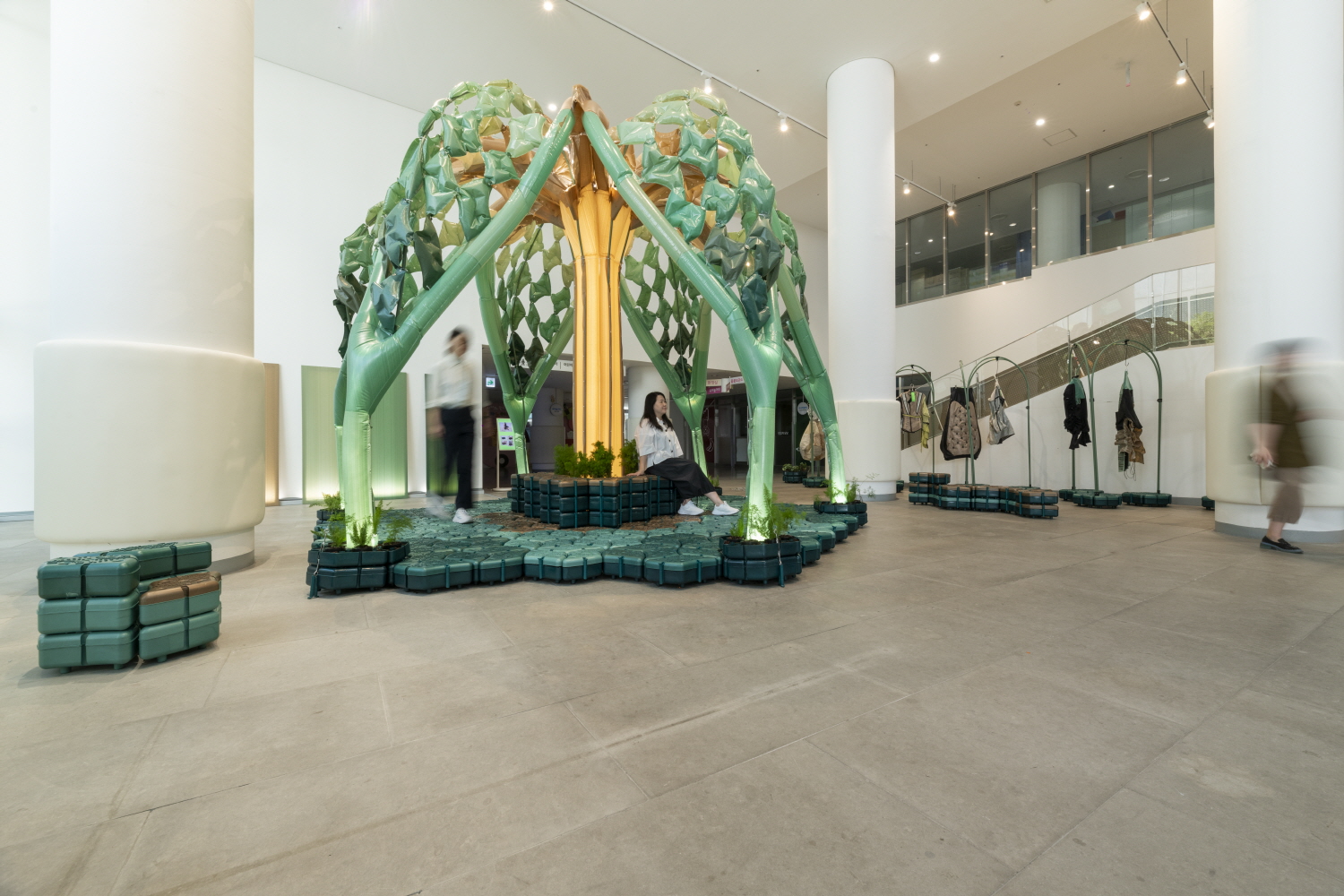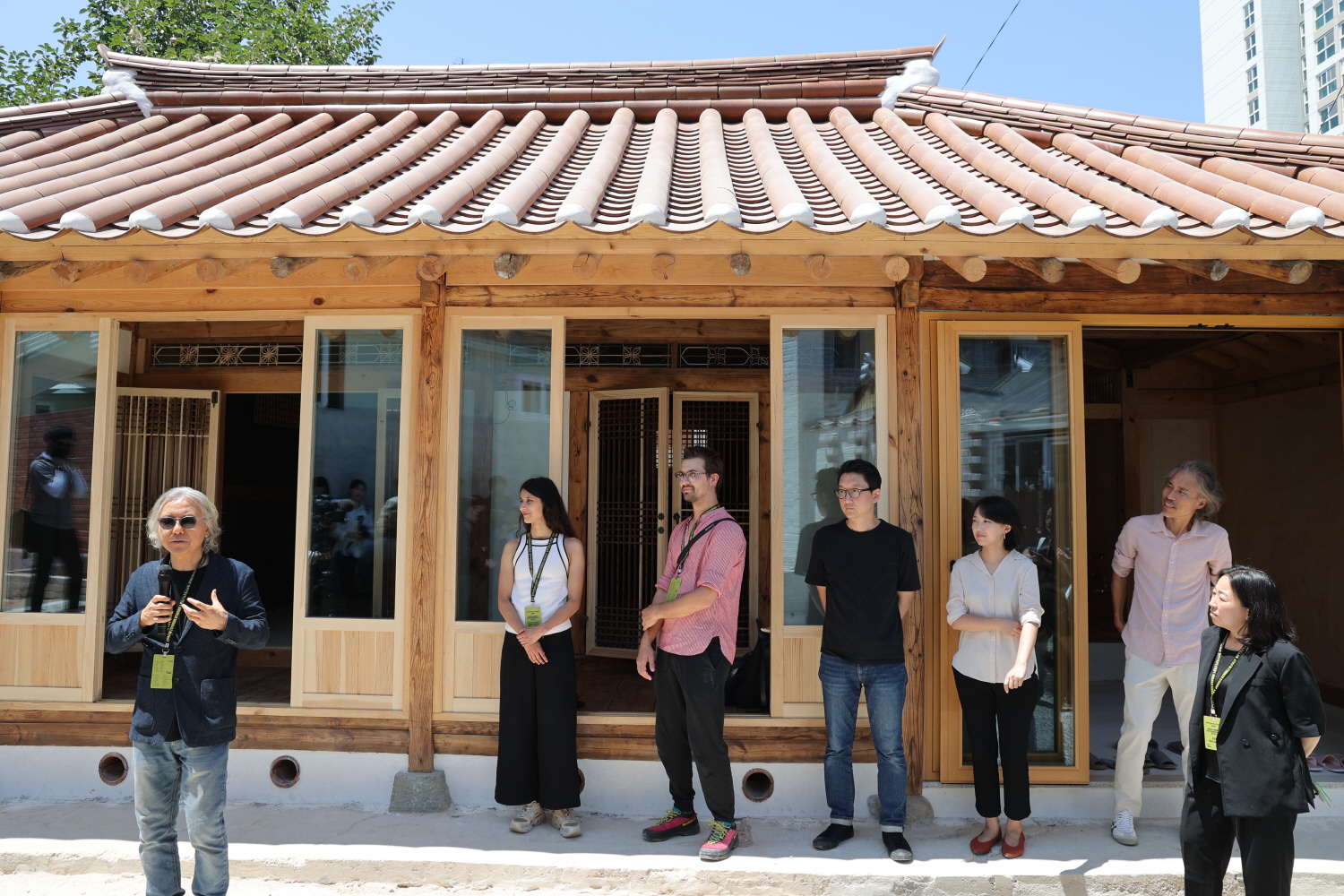SPACE Aug 2024 (No. 681)

Exhibition view of ‘Air Folly – Material Circularity’ / Images courtesy of Gwangju Biennale Foudation

Pai Hyungmin, director of ‘Re:Folly’, explaining the Eco Hanok / Images courtesy of Gwangju Biennale Foudation
The outline of the 5th Gwangju Folly ‘Re:Folly’ is beginning to take shape. Of the four follies planned, ‘Breathing Folly’ (covered in SPACE No. 671) by Cho Namho (principal, Soltozibin Architects) was unveiled in Nov. last year, followed by Air Folly by BARE (co-principals, Jeon Jinhong, Choi Yunhee) and Eco Hanok by Assemble + BC Architects+ Atelier LUMA, which announced its completion on June 18.
Air Folly was on display at the Asia Culture Center until July 14. Previously, BARE had put the process of experimenting with biodegradable materials using seaweed by-products on show in ‘Circular City’ (covered in SPACE No. 674). This exhibition focuses around a constructive space based on the material experiment that has been going on all this time. Air Folly originates from a seaweed farm in Goheung, Jeollanam-do. Inspired by the plastic mulch and plastic buoys commonly used at the site, BARE set out to find a way to replace the plastic waste with seaweed stems and roots. The result of their extensive research and experimentation is Air Folly, a variable spatial structure that combines the Air Buoys, Air Pillows, and Air Leaf modules. It can be flexibly transformed into any combination of Air Buoys, which form the floor, and Air Pillows and Air Leaf, which form the upper air structure. Each module is designed to be used at different scales and across different industries, as demonstrated by the following examples of different module combinations: the pots and chairs that surround Air Folly and the hangers that line one side of the exhibition space. The hangers display garments made from the seaweed biodegradable materials in collaboration with the department of textile art and fashion design at Hongik University, providing another opportunity for biodegradable materials. BARE explains that the lifespan of Air Folly is deliberately intended to be short. This raises questions about the many everyday products that are designed for a specific purpose and then discarded when they have served their purpose. Air Folly will continue its life as a pavilion, taking on different sizes and faces after it is dismantled.
Eco Hanok by Assemble + BC Architects + Atelier LUMA is a combination of natural materials and contemporary technology to restore an abandoned hanok and courtyard (madang) in the centre of Gwangju. The three teams, based in the U.K., Belgium, and France respectively, are engaged in interdisciplinary and site- specific activities that explore building materials, the process of architectural production, and sustainability. The Eco Hanok aims to provide ecological architecture that links the economy, culture, and resources of Gwangju and the Honam region. Walls are stacked with bricks made from a mixture of cockle shells, recycled Korean tiles are glazed with oyster shell, while rice husks are used for insulation and the walls are painted with plaster that glistens with abalone shell. Natural materials from the Honam regions such as Gwangju, Yeosu, Damyang, and Gimje form the elements of Eco Hanok, revealing the value and sense of beauty of circular resources. Kim Hyeongki (professor, Chosun University) and Yoon Jungwon (professor, University of Seoul) participated in the research and development of materials, Stuga House and Urban Society in the experimental construction and design process, VNH and ANPARK in the landscape architecture, and companies such as Goryung Tile and Sejin Plus in the production of special architectural materials. Pai Hyungmin (professor, University of Seoul), the artistic director of ‘Re:Folly’, emphasised that this collaboration between different agents was the main aim behind this 5th Gwangju Folly. He said that the spirit and methodology of ‘Re:Folly’ means that resources are based as much as possible in the Honam regions, and that research and design capabilities are broadly based both domestically and abroad. ‘Re:Folly’ is scheduled to officially open this fall with the completion of Ito Toyo’s Urushi Shell.





